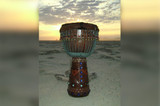The Art of the Drum Solo
For the non-drummer, the idea of a Djembe drum solo may be the
random beating on a drum, expressing one’s inner rhythm, creativity or
the elusive concept of being “carried away” by the music. The benefit
of this illusion for the drummer is being seen as a true artist of
unlimited drumming potential, especially when it appears that just by
chance, the Djembe drummer
manages to blend the solo back into the anticipated rhythm, literally
without missing a beat. Drummers know that drum solos are not just
chance encounters with a rhythmic muse, but a studied method of timing,
harmony and general performance skills, and just a bit of creative
inspiration.
A Djembe drum solo is a complement to the natural rhythms established
by the drum circle that reflect the melody of the song. Traditionally,
the drum solo was a method of playing a rhythm that would correspond to
particular dance moves occurring within the drum circle. It is not
necessarily the absence of other instruments while a drummer plays, but
the addition of a different, harmonious rhythm that follows the same
beat as the drum circle, enhancing the song with slightly different
timing or sounds. Djembe drum soloists must know the basic rhythm being
played by the circle in order to properly break away from the
recognized beat and improvise or produce an accompanying rhythm, as
well as be able to incorporate the solo back into the established song.
Drum circles, while exercises in spirit, creativity and fun, may
have established rules for a soloist. Some circles are open to the
public, and just let the music flow naturally, while others may have
special intentions behind them. Before breaking out in a Djembe solo
during a drum circle, be sure that your rhythmic artistry is wanted and
needed, so you do not throw off the energy and vibe of the circle. Let
others have a turn as a soloist,
as well, and always keep the overall feeling of the circle in mind
when you consider your solo rhythm. Also, remember that a good soloist
is not only able to take on artistic improvisation, but can do so in a
way that does not interrupt the basic rhythm of the drum circle.
Drum solos can be powerful for both the soloist and the other
participants of the drum circle, especially when the solo is perceived
as a seamless integration within the whole experience. The concept of a
Djembe or
other drum solo is not as much about showing off one’s talent, but
enhancing the overall flow and feel of the music being played. This
integration of sound and effect is just as important for the soloist to
know as the basic rhythms being played during the drum circle. For
the Djembe soloist, the art of the drum solo is just as much about
knowing how to combine rhythms together as it is being able to
creatively diverge from the rhythms in play, and bring it all back
together again.
Recent Posts
-
What is the Best Size Djembe for Beginners?
If you're new to the world of percussion and interested in learning the djembe, you're in for a t …16th Jul 2024 -
The Benefits of Becoming a Drumming Teacher: Transforming Passion into Profession
Why become a drumming teacher? Becoming a drumming teacher is an excellent way to share your pas …22nd May 2024 -
What Makes the Djembe Drum a Spiritual Instrument in African Music?
Origin and history of the Djembe drum The Djembe drum originates from West Africa and holds sign …16th May 2024



